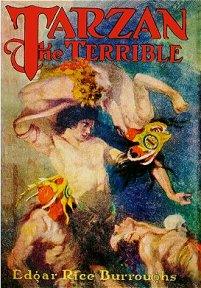 .. ..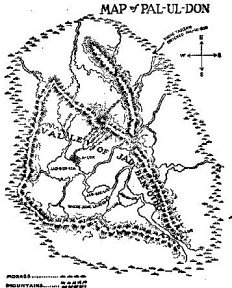 In Tarzan
the Terrible, our hero makes his way through an all but impenetrable
morass of mountains, swamps and steppes to discover a small oval enclave,
about the size of Puerto Rico, approximately fifty miles by ninety.
In Tarzan
the Terrible, our hero makes his way through an all but impenetrable
morass of mountains, swamps and steppes to discover a small oval enclave,
about the size of Puerto Rico, approximately fifty miles by ninety.
There, remarkably, he discovers a new species of lion,
a sabre toothed tiger and at least one species of living dinosaur.
There are other references in the swamps to giant reptiles, including crocodilians,
an apparent plesiosaur or kronosaur, and a giant snake devouring what appears
to be a hadrosaur. There are normal animals, but other Other
animals are not clearly described, but there is a suggestion of both a
diversity of life and some very unusual life.
That's all pretty cool. But the most amazing thing
that Tarzan discovers, are a civilization and apparently three races of
species of a prehensile tailed humanity.
Well, here's my argument: They aren't human.
First, let's take a close look at these creatures.
As Burroughs describes them, they are bipeds, walking easily and naturally
on two feet. Their arms are well shaped and muscular, their legs
shapely. Their facial features are clean cut and shapely, with
flat human-like faces and even teeth no larger than human and with only
minor exaggeration of the canines.
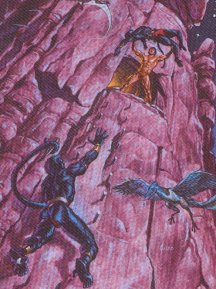 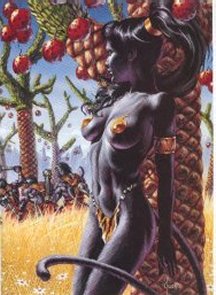
Okay, that seems human enough. But let's look
at a few more details: They all have prehensile tails.
These tails are long enough and versatile enough to use as an extra arm.
Pan At Lee, for instance, uses it to carry bundles of stakes with her.
Others use them in fighting to strangle their enemies. In still
other case, they are used to support greater than the person's entire weight
when wrapped around a tree branch.
They have articulated feet, the big toe is severely exaggerated
and set off at right angles to the rest of the foot. This probably
makes ground travel more problematic, they seem to have no trouble walking,
but may well lose a bit in running and sprinting. On the other hand,
it confers an unparalleled arboreal dexterity. The hands are also
different, the fingers are described as long, and the thumb is proportionately
longer still, extending up to the first joint of the index finger.
(Actually, these features are reported only on the Waz
and Ho Don, and are not mentioned for the Tor O Don, but I think it's a
safe assumption that the Tor O Don possess these attributes).
Burroughs himself writes that they have the tail, thumbs
and big toes of monkeys. Elsewhere, he repeatedly refers to
them as pithecanthropi, or literally ‘ape’ men. Even where
Burroughs remarks on the physical beauty and comeliness of these creatures,
he can't resist drawing attention to their inhuman aspects.
In the same breath, he will wonder if they are human, describe them as
ape-like or ape-men, or describe them as pithecanthropi. (Pithecanthropi,
by the way, are the old name of Homo Erectus, aka Java Man, an early predecessor
of humanity that inhabited Europe Asia and Africa.
It's clear that whatever humanlike characteristics these
creatures have, Burroughs is not at all confident in describing them as
humans. They may be handsome and beautiful, we find many non-human
creatures to be aesthetically beautiful in human terms, but they are viscerally
not quite like us.
Further, they are divided into three races.
We have the caucasian appearing Ho Don, with pink hairless skins and black
scalp hair. We also have the Waz Don with black skins and pelts
of hair or fur over their bodies, among males this is described as shaggy,
but for females, the comparison is to a seal pelt. Finally,
we have the Tor O Don, the most robust and powerful of them, in size and
strength a match for the gorilla, and with atavistically large canine teeth.
All of them are intelligent. The Ho Don live in
cities and have a fairly high degree of social organization and bronze
age technology. The Waz Don maintain a different lifestyle in cave
villages, but clearly have mastered metalworking and weapons. Both
share a language and religion. Even the ferocious Tor O Don
is a tool user and has managed to semi-domesticate the Gryff.
Burroughs is careful to note that although they have a
common language between them (or at least, the Waz Don and Ho Don do, the
Tor O Don is uncertain), but that it is a language unfamiliar to Tarzan
and dissimilar to any he has heard before. And Tarzan
is no linguistic slouch, as he speaks a number of European and African
languages, as well as the tongue of the Mangani. He would almost
certainly be familiar with Arabic and Berber, which he has encountered
in past adventures, and thus would recognize any affinities there.
He may even have encountered the Xhosa dialects. The suggestion
is that Pal Ul Don is home to a unique language family. Now,
that doesn't make them inhuman, but it does seem to isolate them.
So, the first question we must ask ourselves is, are these
creatures human or descended or evolved from humans. One might
perhaps argue that given these creatures humanlike physical and mental
attributes, their obvious possession of language, tools, culture and civilization,
and their possession of humanlike secondary features, like scalp hair on
the Ho Don and breasts on females, that they should be considered human.
But if so, what about the anomalies? Mutation?
That seems unlikely. Consider the tail.
Tails have not been a part of the human heritage for a long long time.
In fact, they seem to have been lost at least ten million years ago, by
the time apes and hominids split from the old world monkeys.
Still, occasionally, mutations happen, or inactive ‘garbage’
or ‘dormant’ genes awaken, and humans are born with tails.
These tails are invariably vestigial appendages only inches long, and mostly
useless.
A prehensile tail, on the other hand, is a completely
different kettle of fish. Prehensile tails are major evolutionary developments,
exactly akin to growing an extra functioning hand. Tails, as you climb
up the evolutionary scale, are an increasingly residual appendage. In fish,
amphibians and some reptiles, the tail is a locomotion organ, used to facilitate
swimming. In fact, for fish and crocodiles, the tail is the main
swimming organ. Move up to dry land critters, and the
tail as in dinosaurs or birds, becomes a balancing organ, no longer used
in direct propulsion. In some cases, as in stegosaurs or ankylosaurs, it
becomes a weapon.
Most mammal species have tails, or residual tails, but
their purpose has diminished even further. A dog's or deer's tail,
for instance, surely isn't functional as an organ of propulsion or even
balance. Instead, for a lot of mammals, a tail is a 'display' appendage,
dogs wag their tails to signal delight, cats puff their tails to show anger
and deer flash their tails to show fear. Sometimes, as with squirrels,
it's a shelter appendage, a kind of portable blanket for cold periods.
For some critters, like cows its just a fly whisk. Only in
dolphins and whales who went back to the sea, did tails become useful for
propulsion. But even among seagoing mammals, the seals found it easier
to grow their limbs into flippers than to regrow a useful swimming tail.
Of course, with apes and humans, the diminishment of the
tail reached its height, as the appendage vanished altogether.
It's likely, from the occasional mutation, that humans still have inactive
genes for tails, but that's about it.
Most of the musculature in a tail is at the front end.
In most cases, the front end musculature is used to swing the entire tail
around, erecting or flapping it. The internal musculature of the tail is
simply used for maintaining internal structure, like posture or rigidity.
A prehensile tail used for climbing or grasping is a unique
appendage. For one thing, the muscular engineering literally has to be
built from the ground up. There is no evolutionary precedent
to fall back on, no old ‘inactive’ or ‘dormant’ genes that you can just
kick awake. The dolphins were able to evolve backwards, taking
a tail which had become increasingly useless and making it useful again.
But in doing this, they were simply invoking the original design and potential.
For a prehensile tail, you need to do things for which the appendage was
never originally evolved, and for which there is minimal history.
The evolutionary trend of shifting the muscles towards
the front end and increasingly weak internal muscles largely devoted to
stiffness is reversed. For fine muscle control, you not only need more
and stronger muscles, you also need a lot more nerves for fine control.
There is substantial neural wiring required.
Off the top of my head, I can think of only three
modern animals with prehensile tails. Some new world monkeys, opossums
and chameleons. There are probably more but I can't think of them right
off the top. Note that they're all unique little tree creatures
in an environment that gives a strong evolutionary advantage to power this
development. They've also quite clearly been branched off and
established as species for quite some time, allowing for the development
of a complex appendage like this over millions of years.
The Opossums and New World monkeys, for instance, evolved
in isolation on South America over fifty million years. The
Chameleons of Madagascar evolved over a similar period of isolation.
Of the three, the new world monkey is by far the most
sophisticated. Chameleons and opossums simply use their tails as gripping
organs, winding it around tree branches to anchor themselves. The monkey's
tail, on the other hand, is actually used as an extra limb, sensitive and
versatile enough to even pick up a peanut, or to support their entire weight
swinging from it.
In essence, a prehensile tail on the order of New World
Monkeys or the Pal Ul Don inhabitants is a singular evolutionary creation
requiring a very high degree of evolution.
You ain't going to get that kind of development out of
a quick and dirty mutation. Rather, it represents lots of mutation over
a long period.
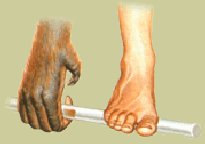 There are other anomalous features beyond the tail. The Pal
Ul Don's seem to have prehensile feet with toes set off at right angles.
Admittedly, this feature is seen in our close relatives, the apes, so it
is part of our broad evolutionary heritage. On the other hand,
it is not a feature seen anywhere in the hominid lines in the last five
million years. Again, to get that in humans, you need
a large number of additional quick and dirty mutations.
There are other anomalous features beyond the tail. The Pal
Ul Don's seem to have prehensile feet with toes set off at right angles.
Admittedly, this feature is seen in our close relatives, the apes, so it
is part of our broad evolutionary heritage. On the other hand,
it is not a feature seen anywhere in the hominid lines in the last five
million years. Again, to get that in humans, you need
a large number of additional quick and dirty mutations.
The extension of the fingers, and particularly the extension
of the thumb and the addition of an apparent extra joint in the thumb offers
the requirement for another set of mutations. Of the different
sets, this is the most loosely plausible.
So, the choices are (1) that a human population
managed, by sheer luck, to backtrack a lost physical feature, regrowing
it, and super-refining it to almost unique levels, while also developing
and refining two other physical features and then speciating into three
races, all in a very short time span; Or (2) a
primate population with these physical feature established managed to evolve
into a human analogue, and speciate, possibly over a long period of time.
Frankly, the Monkeys are just a better bet.
The Pal Ul Don people aren't off of any hominid line.
The best thinking is that they're a gigantic, highly evolved version of
spider monkeys.
This itself, is a prospect not out of the question.
Remember that South America existed as a separate continent isolated from
others for much of its history. Isolated from the rest
of the world for at least fifty million years, South America produced an
amazing assortment of creatures.
The most famous of these, of course, are the
Giant Sloths and Glyptodonts, some of which grew to the size of elephants.
But there were also immense condors of 24 foot wingspans called Teratorns,
and the Phoracid flightless birds, eight foot tall predators with beaks
that could sever a horses head.
 South America was a laboratory for parallel evolution. It produced
the Pyrotheres, who were fake elephants, complete with trunks, six tusks
and comparable size. It produced alternate versions of deer,
antelope, camels and even giraffes. Marsupials produced predators
including versions of lions, wolves, hyeana and even sabre toothed cats.
South America was a laboratory for parallel evolution. It produced
the Pyrotheres, who were fake elephants, complete with trunks, six tusks
and comparable size. It produced alternate versions of deer,
antelope, camels and even giraffes. Marsupials produced predators
including versions of lions, wolves, hyeana and even sabre toothed cats.
Meanwhile, in the jungles, the South American monkeys
were separated from their old world cousins for fifty million years.
South America lacked apes or hominids, so the monkeys had no competitors.
It would have been possible for the South American monkeys
to have evolved larger and larger forms until they had apelike specimens,
and even to have evolved something close to humans.
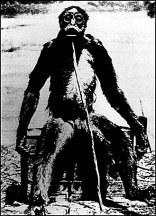 Interestingly, there is at least a few suggestions outside the fossil record
that this may have happened. In 1929, Francois De Loys, a Swiss
Geologist, claimed that in an expedition to South America in 1920, to have
shot a gigantic aggressive biped monkey which walked upright and stood
over five feet tall. There is a famous controversial picture of this
monkey, which, unfortunately, is butt ugly and tailless. The photograph
is commonly dismissed as a common spider monkey, but some primatologists
note differences in chest, hands, shape of face and high forehead to suggest
this may be a real creature. There is extensive folklore, Indian
legends and occasional bigfoot type sightings for giant biped monkeys
approximately five and even six feet tall in Venezuela, commonly known
as “Mono Grande”, which in some reports, uses a club as a weapon.
Certainly if there is a tool using, five foot tall, biped monkey with a
high forehead in South America, then it is a para-hominid rather than a
para-ape. The Mono Grande, from what we know, seems to be a
South American version of Australopithecus or at best, Homo Erectus, rather
than Homo Sapiens. But if indeed it exists at all, it would
still count as a spectacular incidence of parallel evolution. Of
course, this ugly tail-less creature would seem a vast gulp from Burroughs
prehensile tailed, beautiful human-like beings.
Interestingly, there is at least a few suggestions outside the fossil record
that this may have happened. In 1929, Francois De Loys, a Swiss
Geologist, claimed that in an expedition to South America in 1920, to have
shot a gigantic aggressive biped monkey which walked upright and stood
over five feet tall. There is a famous controversial picture of this
monkey, which, unfortunately, is butt ugly and tailless. The photograph
is commonly dismissed as a common spider monkey, but some primatologists
note differences in chest, hands, shape of face and high forehead to suggest
this may be a real creature. There is extensive folklore, Indian
legends and occasional bigfoot type sightings for giant biped monkeys
approximately five and even six feet tall in Venezuela, commonly known
as “Mono Grande”, which in some reports, uses a club as a weapon.
Certainly if there is a tool using, five foot tall, biped monkey with a
high forehead in South America, then it is a para-hominid rather than a
para-ape. The Mono Grande, from what we know, seems to be a
South American version of Australopithecus or at best, Homo Erectus, rather
than Homo Sapiens. But if indeed it exists at all, it would
still count as a spectacular incidence of parallel evolution. Of
course, this ugly tail-less creature would seem a vast gulp from Burroughs
prehensile tailed, beautiful human-like beings.
The Mono Grande reports might well have been known to
Burroughs, although he could not have known of Loys photograph, and this
might have inspired him to think of human like monkeys. Of
course, this kind of leap is hardly necessary, it would take only a minimal
amount of imagination to come up with it independently, and Burroughs was
blessed in this regard.
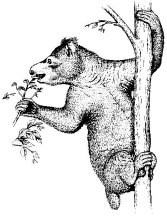 In
terms of parallel evolution producing giant ape or human sized primates,
in fact, we know that something very similar took place in Madagascar where
the lemurs had been isolated from both the Old World and New World monkeys
for at least fifty million years. There, they produced Megaladapis
an orangutan-sized lemur with a long muzzle and widely separated eyes feet
were enormous pincer-like grasping feet, and long and robust forelimbs,
which climbed trees like koalas and subsisted almost entirely on a diet
of leaves. There were also “Sloth” lemurs, so named because
of its remarkable convergences with tree-dwelling sloth of South and Central
America, the largest of which was the gorilla-sized Archaeoindris, and
Palaeopropithecus, a chimpanzee-sized lemur with teeth like those of the
sifaka, but bodies like those of arboreal sloths. These upside-down animals
had long forelimbs and short hind limbs, and enormous, hook-like hands
and feet. An adult Gorilla weighs in at as much as 450 pounds,
and both Chimpanzees and Orangutans can reach human weights and sizes of
100 to 200 pounds. In
terms of parallel evolution producing giant ape or human sized primates,
in fact, we know that something very similar took place in Madagascar where
the lemurs had been isolated from both the Old World and New World monkeys
for at least fifty million years. There, they produced Megaladapis
an orangutan-sized lemur with a long muzzle and widely separated eyes feet
were enormous pincer-like grasping feet, and long and robust forelimbs,
which climbed trees like koalas and subsisted almost entirely on a diet
of leaves. There were also “Sloth” lemurs, so named because
of its remarkable convergences with tree-dwelling sloth of South and Central
America, the largest of which was the gorilla-sized Archaeoindris, and
Palaeopropithecus, a chimpanzee-sized lemur with teeth like those of the
sifaka, but bodies like those of arboreal sloths. These upside-down animals
had long forelimbs and short hind limbs, and enormous, hook-like hands
and feet. An adult Gorilla weighs in at as much as 450 pounds,
and both Chimpanzees and Orangutans can reach human weights and sizes of
100 to 200 pounds.
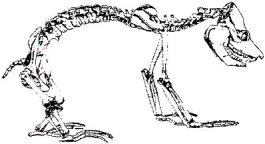 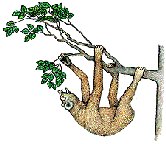 
Effectively, Madagascar's lemurs produced their
own apes and sloths. Madagascar also produced giant peaceful
flightless birds, the so called Elephant Birds, standing ten feet high
and weighing 1000 pounds, as well as giant tortoises, pygmy hippotaomi,
and other exotic life forms.
So, the probability is high that South America actually
did produce its own ‘apes’ to rival the Apes of Africa and Asia, and the
Apelike giant lemurs of Madagascar. And of course, this leaves
the door open to the possibility that South America's monkeys might produce
hominid-like, or hominid-apelike creatures. These jungle creatures
would not easily show up in the fossil record, but there is a fair chance
that they could have evolved. It should be noted that South
America was many times the size of Madagascar, allowing it room to develop
a diversity of flora and fauna and advanced and colossal specimens.
Of course, Madagascar's exotic life lasted a lot longer
than South America's. Madagascar's elephant birds and giant
lemurs may well have survived until the coming of man to their island,
less than two thousand years ago. So it is much easier for
us to find records of the giant extinct lemurs than of hypothetical giant
extinct new world monkeys.
Unfortunately for South America, disaster struck ten million
years ago, when the continent was joined to North America by the Isthmus
of Panama. The result was an invasion of old world species
common to Asia, Europe and North America who invaded South and wiped out
the local fauna. The Marsupial imitation cats and wolves were
wiped out by real ones, the false elephants, the giant birds and many others
were driven to extinction.
So, if South America had in fact produced its own versions
of apes, hominids or protohominids, they might well have been wiped out
by the linking of the continents.
Of course a few species, such as the giant land sloths,
armadillos, glyptodonts and opossums survived the onslaught of northern
species and actually managed to move north, extending their range as far
as the US. Only the armadillos and opossums survive to the present
day. But based on this, its possible that South American pseudo-humans
could have survived to have met real humans invading from the old world.
But after that, game over. Humans, because of the 'walking' based, non-prehensile
foot, are simply far more mobile than Burroughs ‘Pal Ul Don’ types, and
this would eventually be an insurmountable advantage.
So, they'd wind up as an extinct species, just like the sabre tooths,
dinosaurs, etc.
Of course, the big problem in classifying the inhabitants
of Pal Ul Don as highly advanced New World Monkeys, is that they should
be in the New World. What are a bunch of South American monkey
men doing in the middle of Africa? It seems flatly impossible.
But then there is a lot about Pal Ul Don that seems flatly
impossible, including the sabre tooth tigers and the triceratops, as well
as assorted other hinted at dinosaur and mammal species.
On the face of it, this is just a headache.
Sabre toothed tigers and giant New World Monkeys certainly didn't co-exist
together. They might possibly have shared the same time period,
but they were living on separate continents. The triceratops,
as far as anyone knows, was not an inhabitant of South America at all,
and was separated by tens of millions of years from its Pal Ul Don contemporaries.
So the notion of them all mixing and matching up in Pal Ul Don seems unlikely.
Unless, of course, we accept that they came from somewhere
else. The problem with New World Monkey Men in Pal Ul
Don is how they get over from South America? There is a solution.
Pellucidar
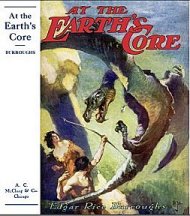
And in fact, if we take a look at At
The Earth's Core, among the first creatures that David Innes encounters
are a remarkable group of Monkey men. Allow me to briefly quote:
“ manlike creatures..... to all
appearances strikingly similar in aspect to the Negro of Africa, except
that the head receded more rapidly above the eyes, leaving little or no
forehead. Their arms were rather longer and their legs shorter in proportion
to the torso than in man, and later I noticed that their great toes protruded
at right angles from their feet. Behind them trailed long, slender
tails which they used in climbing quite as much as they did either their
hands or feet.... one of the creatures in the tree above swung down head
foremost, his tail looped about a great limb, and grasping me beneath my
armpits swung me in safety up among his fellows. ... They turned me about
to see if I had a tail, and when they discovered that I was not so equipped
they fell into roars of laughter. Their teeth were very large and white
and even, except for the upper canines which were a trifle longer than
the others -- protruding just a bit when the mouth was closed.”
Note the powerful prehensile tail, the adapted big toes,
the ‘pithecanthropi’ like description of the receding forehead and the
flat teeth. There's no mention of elongated fingers or thumb,
but this could have been easily overlooked. The only discrepancy
is the proportions of arms and legs to the torso, but even the degree here
is not stated and might have been a mere impression. In essence,
we have here at the Earth's core a description of a creature which would
be right at home in Pal Ul Don.
Like the inhabitants of Pal Ul Don, this creature is intelligent
and not an ape. It lives in a village above the ground, the
inhabitants are organized to the extent of building a communal road network,
they maintain domesticated animals, dogs and milking goats, appear to have
a language, laughter, games and traditions. In essence, they
seem to be roughly on a par with humans, and with the inhabitants of Pal
Ul Don.
In short, there's no reason not to consider them as part
of the same species or family as the inhabitants of Pal Ul Don.
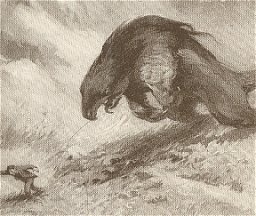 Interestingly, the first animal that David Innes actually encounters in
Pellucidar
is a giant sloth. Giant sloths, of course, were actually native to
South America and evolved there as contemporaries to our hypothetical Monkey
Men. So, unlike Pal Ul Don, we see in this section Pellucidar
a hint of ecological symmetry, of species which evolved in the same region
and the same time, being found together.
Interestingly, the first animal that David Innes actually encounters in
Pellucidar
is a giant sloth. Giant sloths, of course, were actually native to
South America and evolved there as contemporaries to our hypothetical Monkey
Men. So, unlike Pal Ul Don, we see in this section Pellucidar
a hint of ecological symmetry, of species which evolved in the same region
and the same time, being found together.
So, there is our answer. The South American
Monkey Men moved from South America to Pellucidar, along with the Giant
Sloth and presumably Glyptodonts, Pyrotheres, Phoracids and other South
American megafauna.
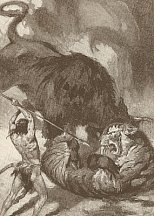 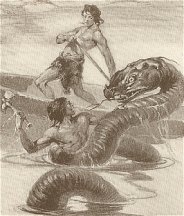 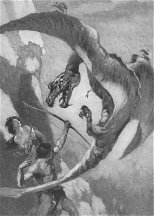
Pellucidar, of course, was not simply a repository
for vanished South American megafauna. The Pellucidar series
reveals creatures from all epochs of life, from triceratops to sabre toothed
tigers, dinosaurs, mammoths, sea monsters, actual ape-men and so on.
So, in fact, once we get into Pellucidar, we find not just the Monkey Men,
but the other anomalous major species seen in Pal Ul Don.
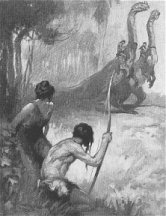 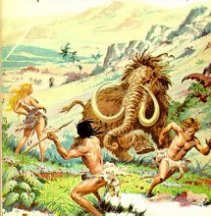 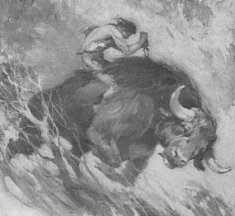
Its possible that the Monkey Men actually evolved
in Pellucidar rather than South America. There is some suggestion
that Pellucidar has evolved its own species, such as the Mahars.
But there is less to this distinction than meets the eye. Even if
the Monkey Men reached their current form and size in Pellucidar, its clear
that their ancestors, and the critical evolutionary features of prehensile
tail, hands and feet, had come from South America.
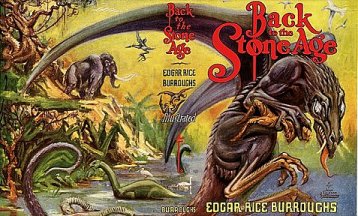 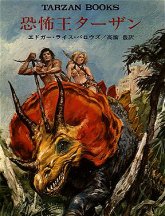
Of course, the big questions that arise is how
Animal populations from various epochs of Earth history actually make it
into Pellucidar, and how they would manage, in the case of places like
Pal Ul Don, to make it back out again. It strikes me
that dinosaurs and tropical monkey men probably wouldn't be travelling
through the Polar openings. Nor does it seem likely that a
Gryff would be travelling through hundreds or thousands of miles of volcanic
passages.
But that's a mystery for another day....
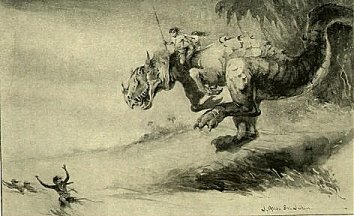
APPENDICES: QUOTED
DESCRIPTIONS OF MONKEY MEN
HO DON DESCRIPTION
(Tarzan the Terrible)
It walked erect upon two feet -- it walked upon two feet
and was hairless except for a black thatch upon its head; its arms were
well shaped and muscular; its hands powerful and slender with long tapering
fingers and thumbs reaching almost to the first joint of the index fingers.
Its legs too were shapely but its feet departed from the standards of all
races of men, except possibly a few of the lowest races, in that the great
toes protruded at right angles from the foot.
his head lifted, his features might readily have been
discerned in the moonlight. They were strong, clean cut, and regular --
features that would have attracted attention for their masculine beauty
in any of the great capitals of the world. But was this thing a man? It
would have been hard for a watcher in the trees to have decided as the
lion's prey resumed its way across the silver tapestry that Luna had laid
upon the floor of the dismal jungle, for from beneath the loin cloth of
black fur that girdled its thighs there depended a long hairless, white
tail.
the man-thing spoke. Tarzan realized that the creature
before him was uttering articulate sounds which expressed in speech, though
in a language with which Tarzan was unfamiliar, the thoughts of a man possessing
to a greater or less extent the same powers of reason that he possessed.
In other words, that though the creature before him had the tail and thumbs
and great toes of a monkey, it was, in all other respects, quite evidently
a man.
a pleasant smile that revealed a row of strong white teeth,
the canines of which were no longer than Tarzan's own
Taking the ape-man by the shoulder he turned him around
so that Tarzan's back was toward him and then, touching the end of Tarzan's
spine with his forefinger, he curled his own tail up over his shoulder
and, wheeling the ape-man about again, pointed first at Tarzan and then
at his own caudal appendage, a look of puzzlement upon his face, the while
he jabbered excitedly in his strange tongue.
The ape-man realized that probably for the first time
his companion had discovered that he was tailless by nature rather than
by accident, and so he called attention to his own great toes and thumbs
to further impress upon the creature that they were of different species....
Pithecanthropus
Having already mastered several languages and a multitude
of dialects the ape-man felt that he could readily assimilate another even
though this appeared one entirely unrelated to any with which he was familiar.
WAZ DON DESCRIPTION
(Tarzan the Terrible, Chapter Two)
In the moment of discovery Tarzan saw that the creature
was almost a counterpart of his companion in size and conformation, with
the exception that his body was entirely clothed with a coat of shaggy
black hair which almost concealed his features,
Though the creature bit at Tarzan the latter was quickly
aware that this was not a particularly formidable method of offense or
defense, since its canines were scarcely more developed than his own. The
thing that he had principally to guard against was the sinuous tail which
sought steadily to wrap itself about his throat and against which experience
had afforded him no defense.... shaggy manlike ape .... pithecanthropus
.....appeared that the heavy, shaggy black figure moved
across the face of the perpendicular wall
.....Upon the edge of this dais sat a young female Waz-don.
In one hand she held a thin piece of metal, apparently of hammered gold,
with serrated edges, and in the other a short, stiff brush. With these
she was occupied in going over her smooth, glossy coat which bore a remarkable
resemblance to plucked sealskin. Her loin cloth of yellow and black striped
jato-skin lay on the couch beside her with the circular breastplates of
beaten gold, revealing the symmetrical lines of her nude figure in all
its beauty and harmony of contour, for even though the creature was jet
black and entirely covered with hair yet she was undeniably beautiful.
TOR O DON DESCRIPTION
(Tarzan the Terrible, Chapter 6)
The dim light that filtered into the dark chamber she
saw a form beside her, she felt hairy fingers upon her and a hairy breast
against which she was being drawn. ....The beast rose now upon its hind
legs
....she knew well the prowess of the beast-like man with
whom it fought. There were not many of them in Pal-ul-don, but what few
there were were a terror to the women of the Waz-don and the Ho-don, for
the old Tor-o-don bulls roamed the mountains and the valleys of Pal-ul-don
between rutting seasons and woe betide the women who fell in their paths.
With his tail the Tor-o-don sought one of Tarzan's ankles,
and finding it, tripped him. The two fell heavily, but so agile was the
ape-man and so quick his powerful muscles that even in falling he twisted
the beast beneath him, so that Tarzan fell on top and now the tail that
had tripped him sought his throat as had the tail of In-tan, the Kor-ul-lul.
....Both hands were occupied for the moment in fending
off the clutching fingers that sought to seize him and drag his throat
within reach of his foe's formidable fangs and now the tail was seeking
its deadly hold with a formidable persistence that would not be denied.
....The battle seemed to be going against him for the
giant beast against which he strove would have been a fair match in weight
and strength for Bolgani, the gorilla.
“It was a Tor-o-don," she replied. "I have seen but one
before. They are terrible creatures with the cunning of man and the ferocity
of a beast
He guessed that it represented either a very high order
of ape or a very low order of man -- something akin to the Java man, perhaps;
a truer example of the pithecanthropi than either the Ho-don or the Waz-don;
possibly the precursor of them both.
The creature, walking erect and carrying a stick in one
hand, advanced at a slow, lumbering gait. It walked directly toward the
gryfs who moved aside, as though afraid. Tarzan watched intently. The Tor-o-don
was now quite close to one of the triceratops. It swung its head and snapped
at him viciously. Instantly the Tor-o-don sprang in and commenced to belabor
the huge beast across the face with his stick. To the ape-man's amazement
the gryf, that might have annihilated the comparatively puny Tor-o-don
instantly in any of a dozen ways, cringed like a whipped cur.
"Whee-oo! Whee-oo!" shouted the Tor-o-don and the gryf
came slowly toward him. A whack on the median horn brought it to a stop.
Then the Tor-o-don walked around behind it, clambered up its tail and seated
himself astraddle of the huge back. "Whee-oo!" he shouted and prodded the
beast with a sharp point of his stick. The gryf commenced to move off.
PELLUCIDAR DON
(At the Earth’s Core, Chapter Two)
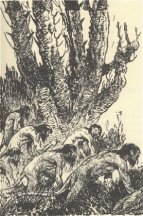 Chattering
and gibbering through the lower branches of the trees came a company of
manlike creatures evidently urging on the dog pack. They were to all appearances
strikingly similar in aspect to the Negro of Africa. Their skins were very
black, and their features much like those of the more pronounced Negroid
type except that the head receded more rapidly above the eyes, leaving
little or no forehead. Their arms were rather longer and their legs shorter
in proportion to the torso than in man, and later I noticed that their
great toes protruded at right angles from their feet -- because of their
arboreal habits, I presume. Behind them trailed long, slender tails which
they used in climbing quite as much as they did either their hands or feet....
one of the creatures in the tree above swung down headforemost, his tail
looped about a great limb, and grasping me beneath my armpits swung me
in safety up among his fellows. ... They turned me about to see if I had
a tail, and when they discovered that I was not so equipped they fell into
roars of laughter. Their teeth were very large and white and even, except
for the upper canines which were a trifle longer than the others -- protruding
just a bit when the mouth was closed. Chattering
and gibbering through the lower branches of the trees came a company of
manlike creatures evidently urging on the dog pack. They were to all appearances
strikingly similar in aspect to the Negro of Africa. Their skins were very
black, and their features much like those of the more pronounced Negroid
type except that the head receded more rapidly above the eyes, leaving
little or no forehead. Their arms were rather longer and their legs shorter
in proportion to the torso than in man, and later I noticed that their
great toes protruded at right angles from their feet -- because of their
arboreal habits, I presume. Behind them trailed long, slender tails which
they used in climbing quite as much as they did either their hands or feet....
one of the creatures in the tree above swung down headforemost, his tail
looped about a great limb, and grasping me beneath my armpits swung me
in safety up among his fellows. ... They turned me about to see if I had
a tail, and when they discovered that I was not so equipped they fell into
roars of laughter. Their teeth were very large and white and even, except
for the upper canines which were a trifle longer than the others -- protruding
just a bit when the mouth was closed.
|













![]()
![]()
![]()
![]()

![]()